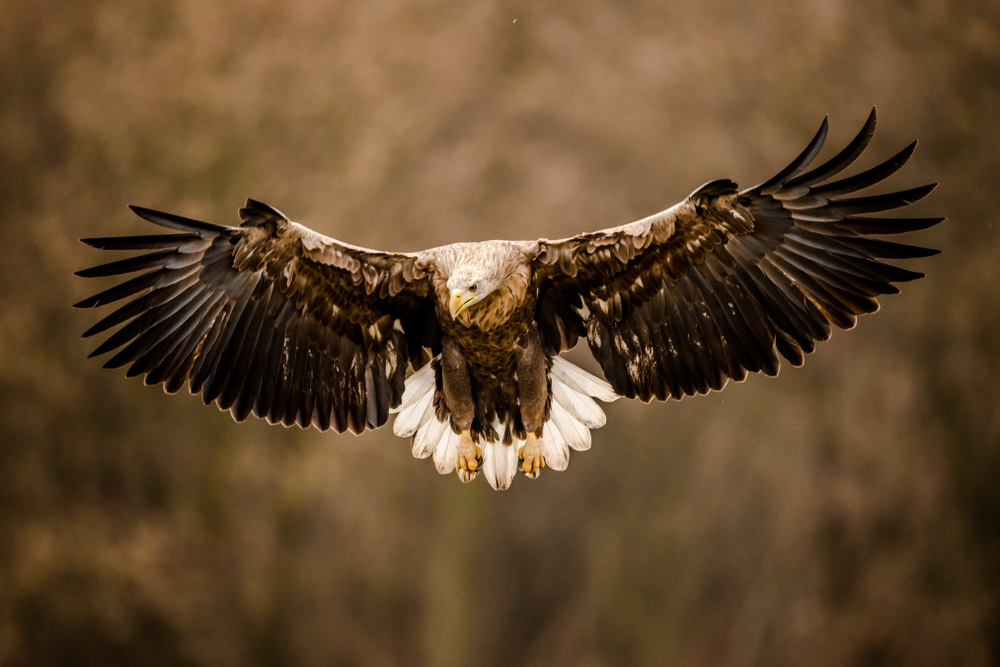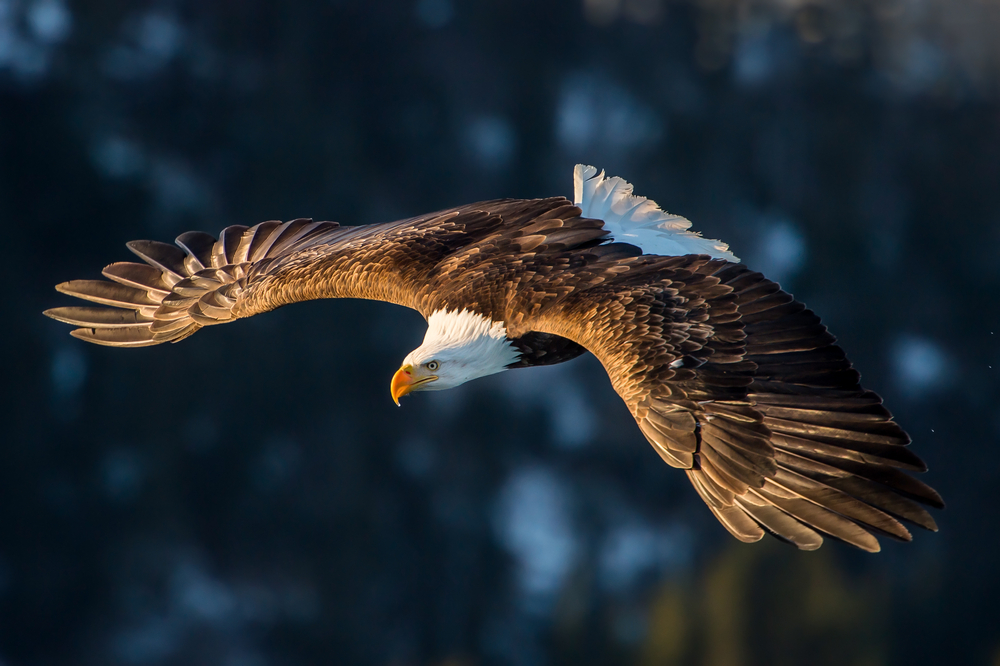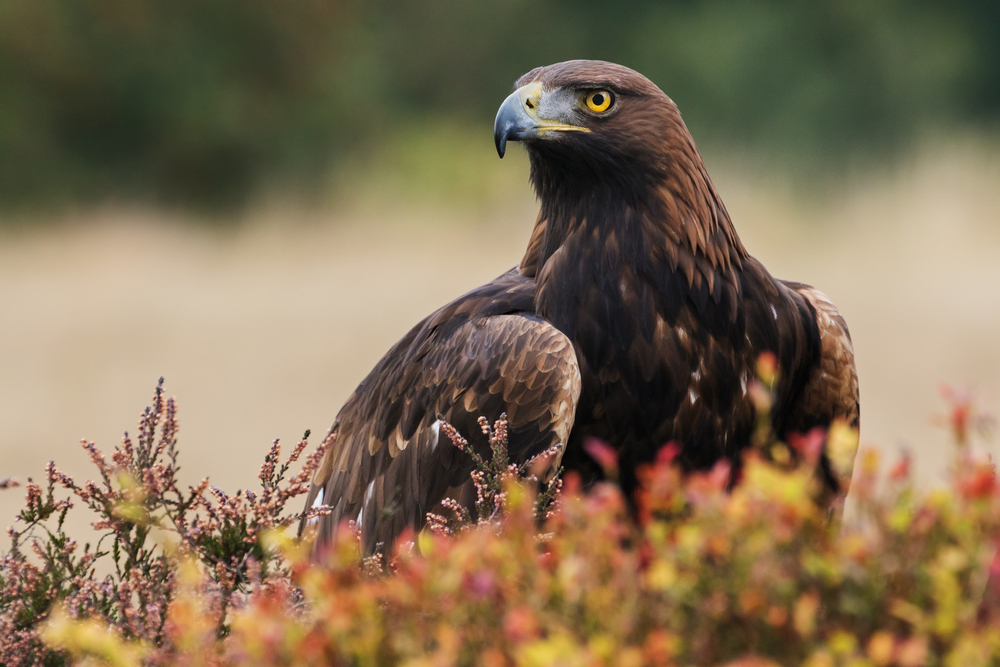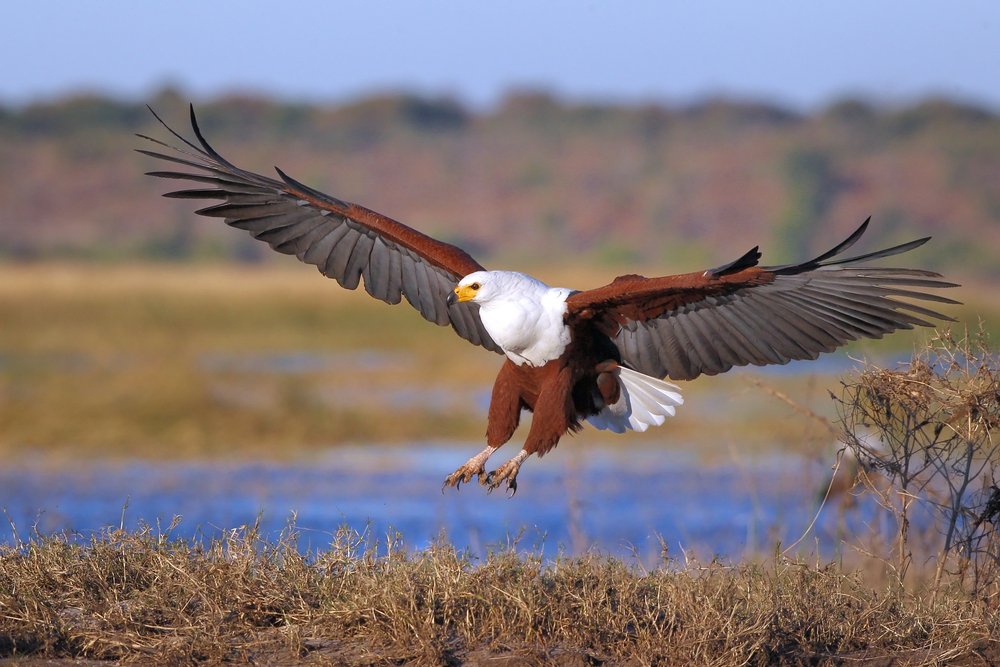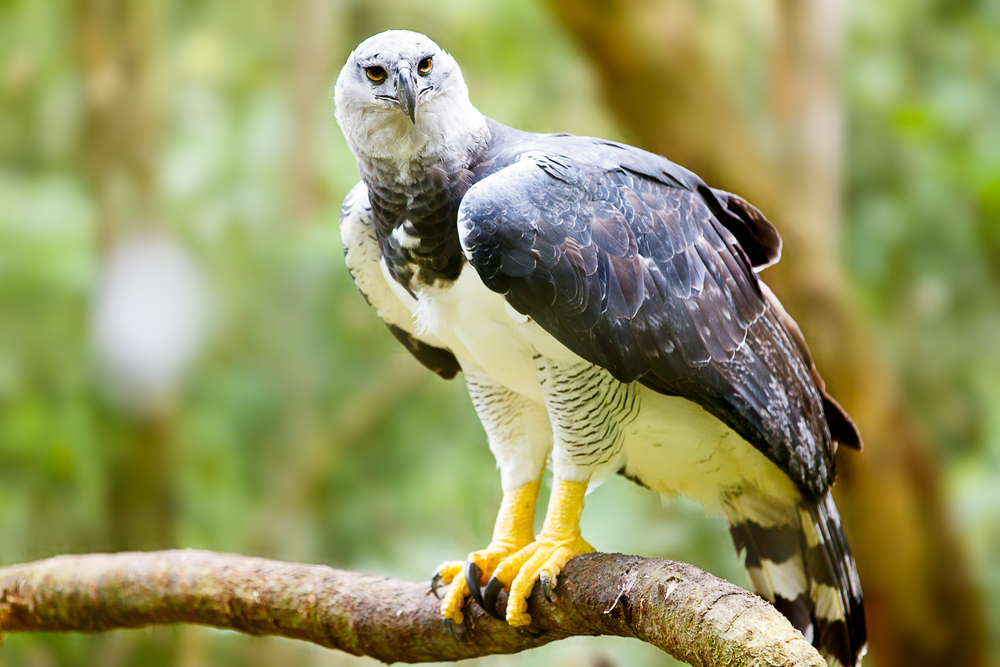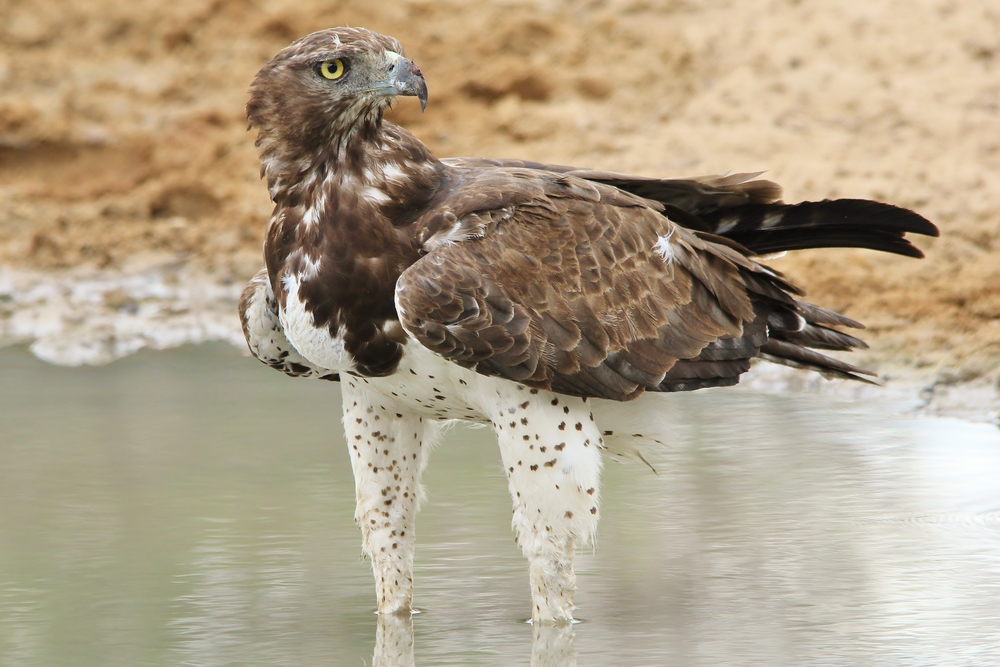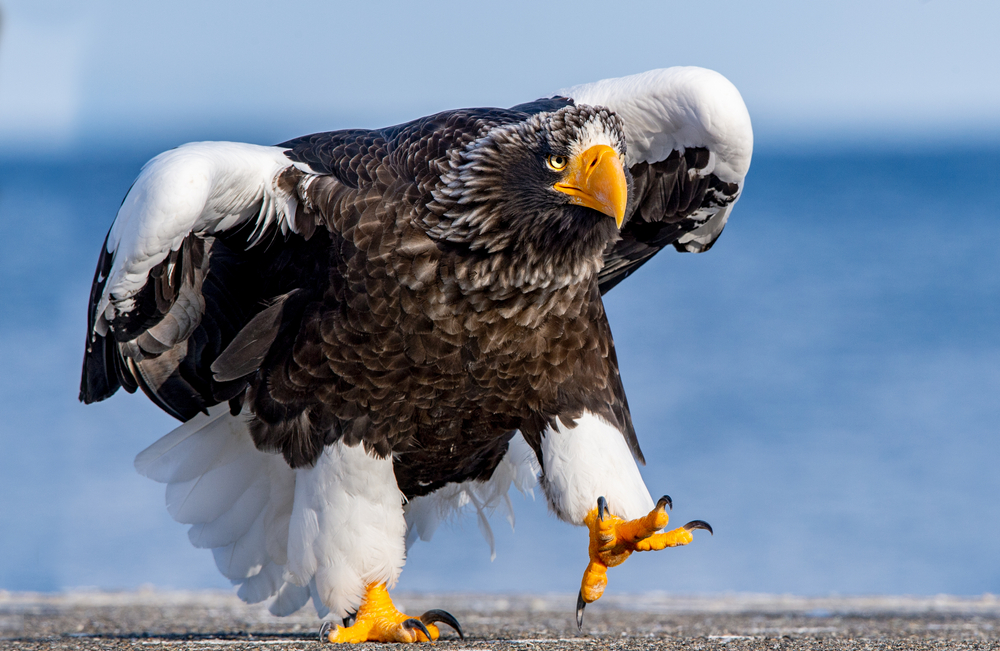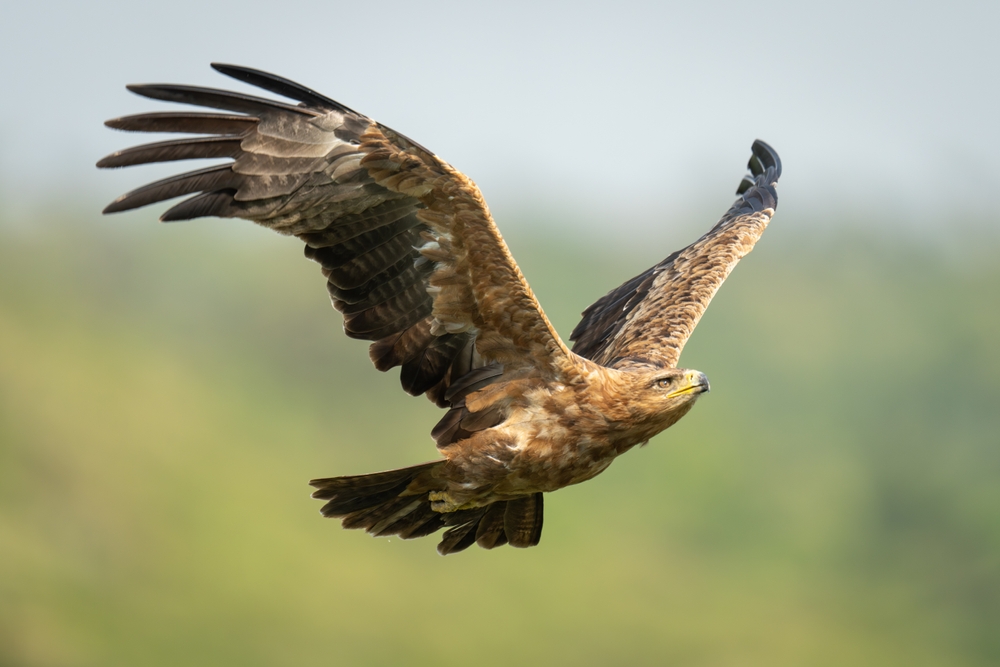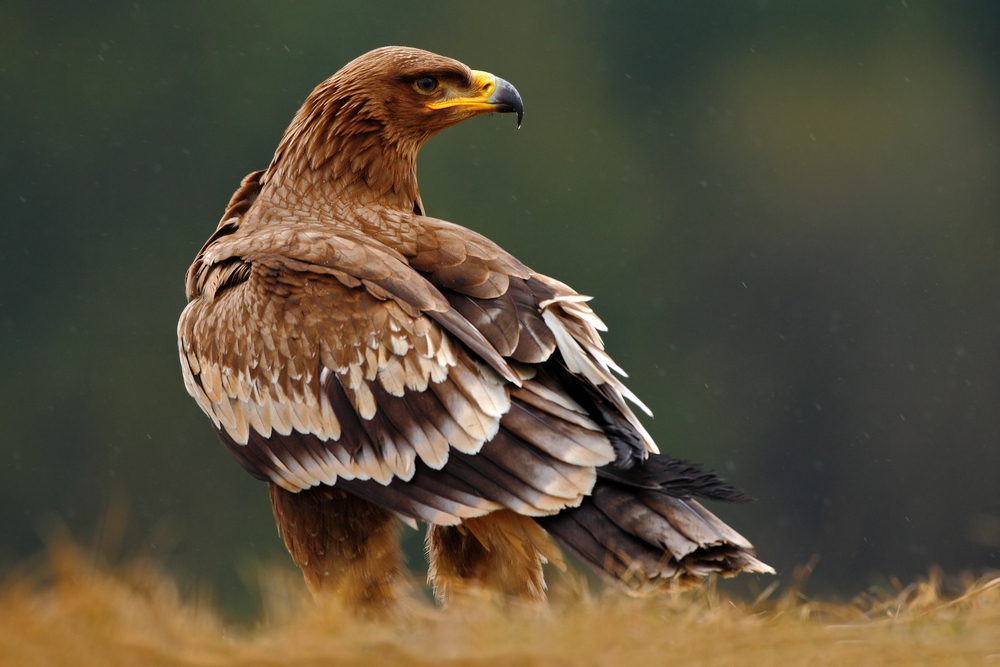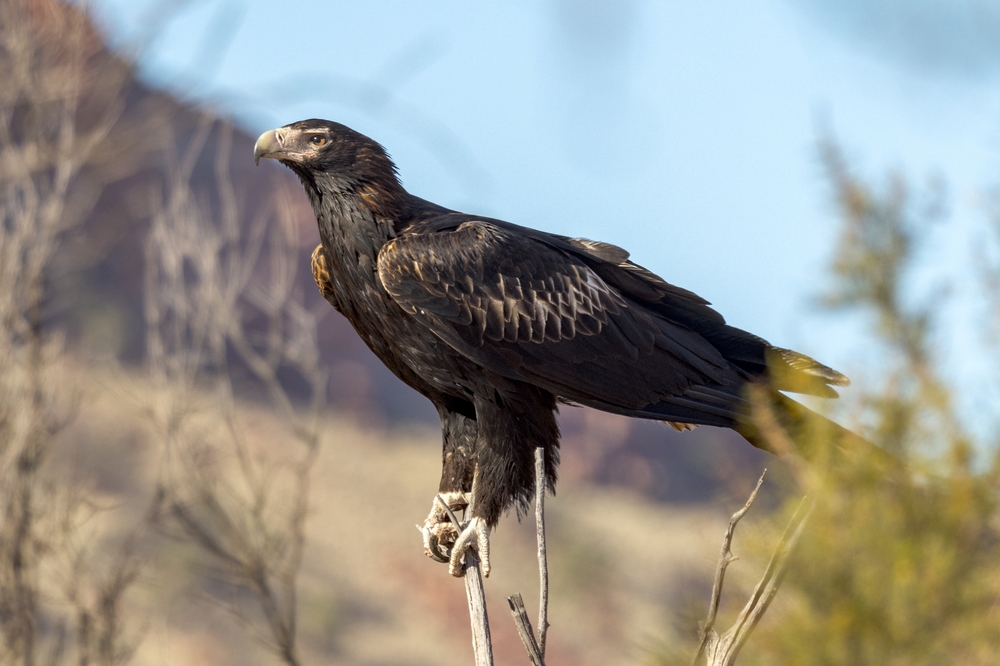The Bald Eagle (Haliaeetus leucocephalus) is its closest relative; the two are sister species that form a species pair, with genetic work suggesting a split roughly ~1 million years ago.
About
The White-tailed Eagle (Haliaeetus albicilla) is one of Europe’s largest and most iconic birds of prey, belonging to the family Accipitridae, which includes hawks, kites, and other eagles. Known as the “sea eagle” across much of its range, this raptor is distinguished by its massive size, broad wings, and wedge-shaped tail. Adults display a striking contrast of a pale head and neck, yellow bill, and pure white tail feathers against a brown body, while juveniles are darker and take up to five years to achieve full adult plumage.
White-tailed Eagles have a wingspan ranging from 2 to 2.4 meters (6.5 to 8 feet), making them the largest European eagle. Their powerful build and commanding flight allow them to soar effortlessly over coastlines, rivers, and wetlands in search of prey. As opportunistic feeders, they primarily hunt fish and waterfowl but will also scavenge carrion, often stealing food from other birds such as ospreys.
This species is distributed across northern Europe and Asia, with strong populations in Norway, Scotland, Germany, Poland, and Russia. After centuries of persecution and habitat loss that nearly drove them to extinction in parts of Western Europe, intensive conservation programs and reintroduction projects have led to a remarkable recovery, especially in the United Kingdom and Ireland.
White-tailed Eagles usually nest in tall trees or cliffs close to water, building enormous stick nests that may be used for decades and expanded annually. Pairs are monogamous, often staying together for life, and are known for their spectacular aerial courtship displays.
Regarded as a symbol of wilderness and freedom, the White-tailed Eagle plays an important ecological role as both predator and scavenger. Its successful comeback is considered one of Europe’s greatest conservation achievements, reflecting the resilience of nature when given protection and care.
Physical Characteristics
The White-tailed Eagle (Haliaeetus albicilla) is a large bird of prey with a commanding presence and distinctive features:
Plumage: Adults display a mostly brown body with paler heads and necks, giving them a slightly golden wash. The most recognizable feature is their bright white, wedge-shaped tail, contrasting sharply with their darker feathers. Juveniles are uniformly dark brown and gradually gain the white tail over 5–6 years.
Head & Beak: They have a large, pale head with a powerful, hooked yellow beak adapted for tearing flesh. Their piercing eyes are yellow and set forward, providing keen binocular vision.
Body & Wings: The body is robust with broad, rectangular wings that can span impressively wide. Their flight is slow and steady, with deep wingbeats and long glides, often resembling a “flying barn door” due to their massive wing surface.
Size:
-
Length (Body): 28–37 in (70–94 cm)
-
Wingspan: 6.0–8.0 ft (1.8–2.45 m)
-
Tail Length: 10–14 in (25–35 cm)
Weight:
-
Adult Female: 10–15 lbs (4.5–7.0 kg)
-
Adult Male: 8–12 lbs (3.5–5.5 kg)
The White-tailed Eagle’s physical traits—particularly its broad wings, wedge-shaped white tail, and commanding size—make it one of Europe’s largest and most easily recognized birds of prey.
Reproduction
The reproductive cycle of the White-tailed Eagle (Haliaeetus albicilla) follows a seasonal rhythm, with courtship, nesting, and chick-rearing occurring in clearly defined stages:
1. Mating and Courtship:
White-tailed Eagles are monogamous and often form lifelong pair bonds. Courtship displays include spectacular aerial maneuvers, with pairs locking talons midair and tumbling together before releasing. These rituals strengthen the pair bond each breeding season.
2. Breeding Season:
Breeding usually begins in late winter to early spring (February to April, depending on latitude). Pairs reuse and expand massive stick nests, sometimes reaching over 6.5 ft (2 m) in diameter and weighing hundreds of pounds. Nests are typically placed in tall trees or on coastal cliffs.
3. Egg Laying and Incubation:
The female lays 1–3 eggs, though 2 is most common. Eggs are pale white and relatively large. Incubation lasts about 38–42 days, with the female doing most of the sitting while the male provides food.
4. Hatching and Chick Development:
Chicks hatch asynchronously, leading to size differences among siblings. Only the strongest often survive if food is scarce, a phenomenon known as cainism. The young are covered in white down at birth and require constant care and feeding.
5. Fledging:
Chicks remain in the nest for 10–11 weeks before fledging. During this period, both parents provide food, with the female often staying closer to the nest. Even after fledging, juveniles may depend on their parents for several more weeks as they develop hunting skills.
6. Sexual Maturity:
White-tailed Eagles reach breeding maturity between 5–6 years of age, once they attain full adult plumage with the characteristic white tail and pale head.
The White-tailed Eagle’s reproductive strategy—low clutch size, high parental investment, and delayed maturity—reflects its adaptation as a long-lived raptor at the top of its ecosystem.
Lifespan
The White-tailed Eagle (Haliaeetus albicilla) is a long-lived raptor, with survival influenced by natural conditions and human activity.
Lifespan in the Wild:
In their natural habitats, White-tailed Eagles generally live 20 to 25 years. Survival is shaped by prey availability, nesting success, disease, and threats such as poisoning, collisions with power lines, and persecution. Juvenile mortality is high, particularly during the first two years, but those that reach maturity often live for decades.
Lifespan in Captivity:
Under the protection of wildlife parks, zoos, and rehabilitation centers, White-tailed Eagles can live up to 40 years or more. Consistent food supply, veterinary care, and absence of predators contribute to this extended longevity.
Threats to the White-tailed Eagle:
-
Habitat Loss: Deforestation and wetland drainage reduce available nesting and feeding grounds.
-
Human Disturbance: Recreational activities, forestry, and development near nesting areas can cause nest abandonment.
-
Poisoning and Persecution: Historically persecuted, they were nearly extinct in parts of Europe by the 20th century. Accidental poisoning from pesticides and lead contamination remain concerns.
-
Collisions: Power lines and wind turbines pose risks, especially in migration corridors.
-
Food Scarcity: Overfishing or pollution can reduce fish stocks and waterfowl, their main prey base.
Conservation Efforts:
Reintroduction programs, habitat protection, and legal safeguards have helped restore White-tailed Eagle populations across Europe. In many regions, they are now a conservation success story, symbolizing the resilience of large raptors when given protection.
Eating Habits
The White-tailed Eagle (Haliaeetus albicilla) is a powerful carnivorous raptor with highly adaptable feeding behaviors:
Diet:
White-tailed Eagles primarily prey on fish and waterbirds, but they are opportunistic and will consume a wide variety of food. Their diet includes fish such as salmon, trout, and pike, as well as ducks, geese, and gulls. They also scavenge carrion, including dead seals, deer, or livestock, and readily steal prey from other birds such as ospreys.
Hunting Strategy:
These eagles hunt using soaring flight and sharp eyesight to locate prey from a distance. They swoop down to snatch fish directly from the water surface or ambush waterbirds resting on lakes or coasts. Unlike fast aerial hunters, their style relies on strength, surprise, and persistence rather than speed.
Scavenging Behavior:
White-tailed Eagles are skilled scavengers, often feeding on carcasses and taking advantage of winter kills or human discards such as fish remains. This scavenging habit plays an important ecological role in recycling nutrients.
Feeding Habits:
They use their powerful beak and talons to tear apart prey. A single large fish or waterbird can provide a day’s food for a pair. Parents feed chicks by tearing food into small pieces and passing it directly to the young.
Hunting Success:
Their hunting efficiency is variable. While adept at catching weakened or unsuspecting prey, they often prefer easier meals through piracy or scavenging, conserving energy for survival and raising young.
Solitary and Pair Feeding:
Though generally territorial and solitary hunters, White-tailed Eagles often hunt in pairs during breeding season. In winter, they may congregate at food-rich sites such as fish runs or carcass dumps.
The White-tailed Eagle’s flexible diet and ability to scavenge as well as hunt make it a highly adaptable top predator and keystone species in its environment.
Uniqueness
The White-tailed Eagle (Haliaeetus albicilla) is one of the most iconic raptors in Europe and Asia, possessing several distinctive traits that set it apart from other eagles:
Largest European Eagle: With a wingspan of up to 8 ft (2.45 m), it is the largest eagle in Europe, often described as a “flying barn door” due to its broad wings and slow, powerful flight.
Signature Tail: Its wedge-shaped, bright white tail in adulthood is the most defining feature, contrasting sharply with its otherwise dark brown body. Juveniles take 5–6 years to gain this striking characteristic.
Aerial Courtship Displays: Pairs engage in dramatic sky dances, including cartwheeling flights where they lock talons and tumble toward the ground before releasing—a spectacular ritual that reinforces pair bonds.
Flexible Feeding: Unlike many raptors, the White-tailed Eagle is highly opportunistic, feeding on fish, birds, carrion, and even stealing prey from other species like ospreys. This adaptability has been key to its survival.
Longevity and Fidelity: These eagles are long-lived, with lifespans reaching 25 years in the wild and over 40 in captivity. They are also known for lifelong monogamy and reusing the same massive nests year after year.
Conservation Symbol: Once nearly eradicated in parts of Europe due to hunting and poisoning, the species has become a conservation success story. Reintroduction programs have restored populations in countries such as Scotland and Ireland, making it a flagship species for raptor conservation.
Cultural Importance: Revered in Norse mythology as a bird of wisdom and strength, the White-tailed Eagle remains a symbol of wild nature across Northern Europe.
The White-tailed Eagle’s size, adaptability, cultural heritage, and remarkable comeback from near-extinction make it a truly unique and celebrated bird of prey.
Be the First to Share Photos of This Species.
FAQ’s
1. What is the closest species to the White-Tailed Eagle?
2. Is the White-tailed Eagle the largest eagle in Europe?
Yes. With a wingspan reaching up to 8 ft (2.45 m), it is the largest eagle in Europe and among the most powerful raptors in the Northern Hemisphere.
3. Do White-tailed Eagles mate for life?
Yes. They are monogamous and usually pair for life, reusing the same enormous nests for many years, adding new material each breeding season.
4. Are White-tailed Eagles a conservation success story?
Yes. Once persecuted to near extinction in several regions, they have made a strong comeback through reintroduction programs and legal protection across Europe.
5. How does the White-Tailed Eagle compare to other eagles?
The White-tailed eagle varies in a few ways with similarities in other ways:
-
Bald Eagle: Very similar size and ecology (both are sea eagles). White-tailed Eagles average a touch heavier with a slightly larger wingspan; both specialize in fish and carrion.
-
Golden Eagle: Golden Eagles are built more for upland/terrestrial hunting (hares, ungulate fawns) and typically have a bit shorter wingspan on average; diets and habitats overlap less.
-
Steller’s Sea Eagle: Noticeably bigger and heavier; overlaps with White-tailed Eagles in far NE Asia (e.g., Hokkaido in winter).
6. What national parks provide the best opportunities to see a White-Tailed Eagle?
The White-tailed eagle might be seen in the following locations:
-
Matsalu National Park, Estonia – Famous for sea eagles and excellent towers (e.g., Haeska) with regular sightings and even nest webcams.
-
Müritz National Park, Germany – “Land of a thousand lakes” with hides specifically for spotting White-tailed Eagles.
-
Woliński National Park, Poland – Long-standing stronghold; over 100 individuals may winter here.
-
Varangerhalvøya National Park, Norway – Coastal tundra park where White-tailed Eagles are regularly observed along the outer coastline.
-
Shiretoko National Park, Japan (Hokkaidō) – Winter drift-ice boat trips routinely view both White-tailed and Steller’s Sea Eagles (late Jan–mid-Mar).



































































